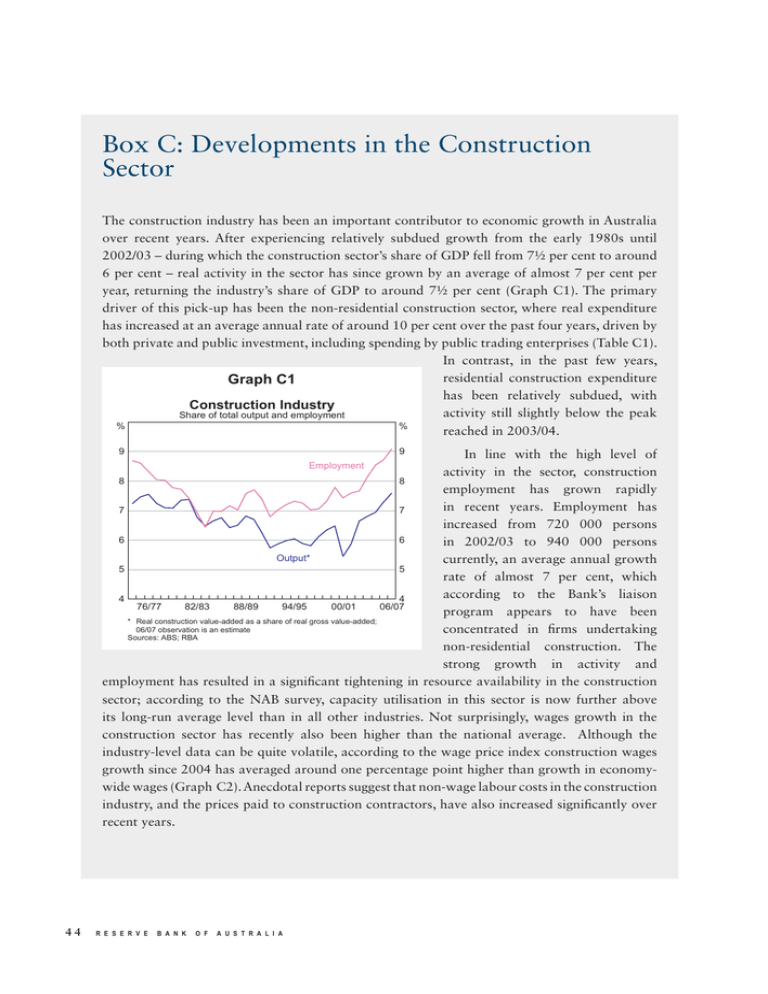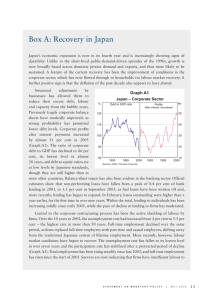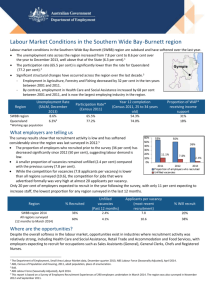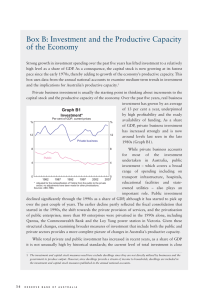Box C: Developments in the Construction Sector
advertisement

Box C: Developments in the Construction Sector The construction industry has been an important contributor to economic growth in Australia over recent years. After experiencing relatively subdued growth from the early 1980s until 2002/03 – during which the construction sector’s share of GDP fell from 7½ per cent to around 6 per cent – real activity in the sector has since grown by an average of almost 7 per cent per year, returning the industry’s share of GDP to around 7½ per cent (Graph C1). The primary driver of this pick-up has been the non-residential construction sector, where real expenditure has increased at an average annual rate of around 10 per cent over the past four years, driven by both private and public investment, including spending by public trading enterprises (Table C1). In contrast, in the past few years, residential construction expenditure Graph C1 has been relatively subdued, with Construction Industry activity still slightly below the peak Share of total output and employment % % reached in 2003/04. In line with the high level of activity in the sector, construction 8 8 employment has grown rapidly in recent years. Employment has 7 7 increased from 720 000 persons 6 6 in 2002/03 to 940 000 persons Output* currently, an average annual growth 5 5 rate of almost 7 per cent, which according to the Bank’s liaison 4 4 06/07 76/77 82/83 88/89 94/95 00/01 program appears to have been * Real construction value-added as a share of real gross value-added; 06/07 observation is an estimate concentrated in firms undertaking Sources: ABS; RBA non-residential construction. The strong growth in activity and employment has resulted in a significant tightening in resource availability in the construction sector; according to the NAB survey, capacity utilisation in this sector is now further above its long-run average level than in all other industries. Not surprisingly, wages growth in the construction sector has recently also been higher than the national average. Although the industry-level data can be quite volatile, according to the wage price index construction wages growth since 2004 has averaged around one percentage point higher than growth in economywide wages (Graph C2). Anecdotal reports suggest that non-wage labour costs in the construction industry, and the prices paid to construction contractors, have also increased significantly over recent years. 9 9 Employment 44 R E S E R V E B A N K O F A U S T R A L I A Table C1: Measures of Construction Activity1 Chain volumes, percentage change Value added(a) 2003/04 2004/05 2005/06 2006/07(b) Average Expenditure Employment Non-residential Residential 5.6 10.2 16.9 8.6 10.3 4.6 –1.5 –4.0 3.8 0.6 6.6 4.8 8.3 7.5 6.8 8.0 7.7 4.8 6.9 6.8 (a) Gross value added at basic prices (b) Estimate Source: ABS The strong demand for Graph C2 construction employment has been Wage Growth met from several sources. Both the Year-ended percentage change Bank’s liaison program and other % % Wage price index 6 6 sources suggest some movement of Construction 5 5 workers from other industries in 4 4 response to strong labour demand All industries* 3 3 in the resource-rich states and the non-residential construction sector % % Enterprise bargaining agreements New, annualised more generally. Construction firms 6 6 have also increased their hiring 5 5 of apprentices and other younger 4 4 staff. According to ABS data, the 3 3 number of apprentices working in 2007 2001 2002 2003 2004 2005 2006 * Data are seasonally adjusted the construction industry has almost Source: ABS doubled since 2002 – accounting for more than half of the rise in total apprentice numbers – and the number of construction workers aged 15–24 years has increased by 10 per cent a year since 2002/03. In addition, the strong demand appears to have kept older workers in the industry for longer; the number of employees aged 55 years and over has increased by 12 per cent a year since 2002/03. Construction firms have also attracted additional labour through targeted migration. Looking forward, there are reasons to expect that construction demand will remain relatively high over the next couple of years. Although growth in non-residential construction is likely to moderate from its recent rapid pace, the stock of private work yet to be done remains high, particularly in the mining sector, and data on business investment intentions point to further growth in activity. Public sector capital spending is also budgeted to continue to increase. 1 Construction industry data are on a value-added basis. Data for residential and non-residential construction refer to expenditure as value-added data are not available. S T A T E M E N T O N M O N E T A R Y P O L I C Y | A U G U S T 2 0 0 7 45 Furthermore, new dwelling construction looks set to rise, given that recent levels of new housing construction have been well below the underlying rate of household formation. An important issue is the extent to which this demand can be met by the labour and other inputs available. Some additional labour to meet forecast demand could be available assuming some further increases in the participation rate and in migration and apprentice training. Nonetheless, it seems unlikely that construction employment can continue to grow over the medium term at the pace seen since 2002/03 without exerting additional pressure on the already tight labour market. These pressures would increase if non-residential construction growth does not moderate as anticipated, or the recovery in residential construction is stronger than expected. R 46 R E S E R V E B A N K O F A U S T R A L I A







